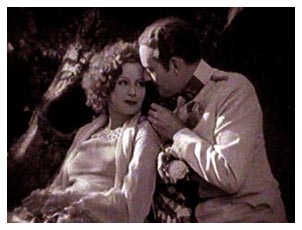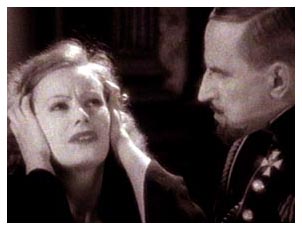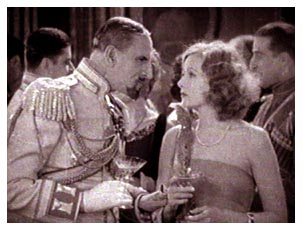

MGM
Cast: Greta Garbo (Tania Federova), Conrad Nagel (Karl von Raden),
Gustav von Seyffertitiz (General Boris Alexandroff), Albert Pollet
(Max Heinrich), Edward Connelly (Colonel Erik von Raden), Richard
Alexander (General's Aide)
First, let's consider the neat and concise overview of the plot by Michael Conway, Dion McGregor, and Mark Ricci in The Films of Greta Garbo:
 "Before the First World War,
Tania (Garbo), a Russian spy, has a love affair with Austrian
Captain Karl von Raden (Conrad Nagel) in order to get secret plans
that he has in his possession. She falls in love with him but
steals the plans anyway.
"Before the First World War,
Tania (Garbo), a Russian spy, has a love affair with Austrian
Captain Karl von Raden (Conrad Nagel) in order to get secret plans
that he has in his possession. She falls in love with him but
steals the plans anyway.
"Karl is court-martialed and jailed. His uncle (Albert Pollet) helps him to escape, and Karl goes to Russia to find Tania. He does find her and learns she really loves him.
"Tania dedicates herself to Karl's cause and double-crosses her spy chief, General Alexandroff (Gustav von Seyffertitz). She gets papers that Alexandroff received from an Austrian traitor and gives them to Karl. When Alexandroff finds out, Tania is forced to . . ."
That's enough. You expect me to give away the ending of
an espionage thriller/romance and spoil the fun?
Yes, fun. I remember watching the old Gold Key Entertainment edition of the film (with tints and musical score added) when it was telecast on ETV (I think it was) back in the 1970's; and I grinned all the way through without quite knowing why until, some years later, I read Richard Corliss's comment in his 1974 study "Greta Garbo":
"'The Mysterious Lady' is vintage nonsense, and most
welcome. It offers us our first real opportunity to gaze at Garbo
without having to avert our gaze from the suffocating seriousness
pecking at her from both sides of the frame. It's the most enjoyable
of her silent films, a lighthearted barnstormer of a show."
It's the most enjoyable
of her silent films, a lighthearted barnstormer of a show."
And there are several reasons that the film, now part of "The Garbo Silents Collection" issued on DVD by Warner Home Video, works so well on its own terms. Let's acknowledge the (few) negatives first:
*The print quality overall is below par -- not as bad as that of "The Single Standard," but enough to be an irritant at times. This appears to be the same print used for the Gold Key edition, subsequently issued on VHS by MGM/UA in the early nineties; scratches abound, and reel changes are rough and worn, compromising what might otherwise be some beautiful close-ups of Garbo. At least the DVD spares us the tinting that Gold Key slathered on its print in an effort to minimize scratches, making the film look as if it had been dipped in marmalade. With the goo gone and happily forgotten, the picture is sharp and detailed for much of the time, and our inclination to cuss whenever deterioration signals an imminent reel change is minimized by -- wait, we'll come back to this point.
*Conrad Nagel. Oh, all right, we've been spoiled by the flashing eyes and teeth and over-the-top passion and brio of John Gilbert; point taken. And Nagel isn't as bad as, say, "The Torrent's" Ricardo Cortez or "Romance's" Gavin Gordon, both of whom make us wonder what Louis B. Mayer and company were thinking. Nagel's easy enough on the eyes; here and in THE KISS, his other film with Garbo, he's conscientious, workmanlike, stolid, earnest, competent -- you get the idea. We admire him for trying. Really. But when Nagel's onscreen -- well, to paraphrase Gertrude Stein, there's just no there there.
But ohhh, man: those positives! Among them:
*The new score by Vivek Maddala, winner of the TCM Young
Film Composers Competition. (Now I'll push the pause button, for
I can hear the screams.) In case you don't know, this score has
been hotly debated on the alt.movies.silent newsgroup. Much of
the dissention centers on whether Maddala should have incorporated
passages from Puccini's TOSCA, a performance of which Garbo and
Nagel attend early in the film. If the visual  cues
we are given are any guide, Garbo may well sing "Vissi d'arte,"
Tosca's signature aria, at three points in the film. So should
Maddala have underscored Garbo's singing with melodies from the
aria? One man's opinion here, but the result would have been absurd:
"Vissi d'arte" is an anguished plea to a God who seemingly
has withdrawn His Hand and Presence from Tosca's life. Garbo sings
the aria -- if in fact that is what she is meant to sing,
for we can't be sure -- romantically, with a smile, and head thrown
back in triumph at the end: not the stuff of "Vissi
d'arte" or even any of the second act of TOSCA. Maddala did
the right thing to avoid Puccini altogether.
cues
we are given are any guide, Garbo may well sing "Vissi d'arte,"
Tosca's signature aria, at three points in the film. So should
Maddala have underscored Garbo's singing with melodies from the
aria? One man's opinion here, but the result would have been absurd:
"Vissi d'arte" is an anguished plea to a God who seemingly
has withdrawn His Hand and Presence from Tosca's life. Garbo sings
the aria -- if in fact that is what she is meant to sing,
for we can't be sure -- romantically, with a smile, and head thrown
back in triumph at the end: not the stuff of "Vissi
d'arte" or even any of the second act of TOSCA. Maddala did
the right thing to avoid Puccini altogether.
Elsewhere, the score is keenly responsive to the film's
moods, by turns light and effervescent, lush and passionate, quietly
suspenseful (just listen during the court-martial scene), thunderingly
climactic. I found myself so keyed up by it, in fact, that at
several points I completely forgot about the film's scratches
and wear -- and it takes a Herculean effort to make that
happen, believe me. I can't guarantee it'll have the same effect
on you, any more than "The Mysterious Lady" or even
Garbo herself will; but run it through your stereo system, crank
up the volume, and lose yourself in the combined power of image
and sound. Maddala's giving 100% effort, highlighting any given
scene's emotional core, as is the film's director, namely --
*Fred Niblo. Now, Niblo's direction can be flat and stagy
on occasion: I find myself returning to "Blood and Sand"
or "The Mark
of Zorro" only for the star power of Valentino and Fairbanks,
rather than the fingertip-drumming lulls between action scenes.
"The Temptress,"
an earlier Garbo vehicle that Niblo took over after her mentor,
Mauritz Stiller, was fired, simply plods; though the DVD (also
in this collection) has a fine score and print, once we're past
the scintillating twenty minutes that Stiller directed, we're
in Pedestrian Land. On the other hand, there's "Ben
Hur," "The Red Lily," and "The Mysterious
Lady." Much of this film's pleasure comes from our awareness
that we're watching a not-always-inspired director confident here
and at the top of his form. With quick tracking shots zeroing
in on actors' faces, superimposed images evoking guilt or wish
fulfillment, synchronized orchestral/stage shots conjuring the
sweep and grandeur of opera, tense cross-cutting during the court-martial
scene -- and these are only a few instances among many -- Niblo
keeps the film swift and fluid, ever true to the rhythm of the
moment. When he does linger, as in Garbo and Nagel's initial rendezvous
(aided here by William Daniels' soft, glowing photography), the
film becomes dreamily suspended. Too, he keeps the performers
in check, with restrained acting unlikely to evoke  titters
from those unaccustomed to silents. He leaves us grinning with
exhilaration, as the fearless and assured tend to do. (For more
on Fred Niblo, see "Remembering
My Father: Fred Niblo" by his son, Peter Niblo, on our
"Articles and Essays"
page.)
titters
from those unaccustomed to silents. He leaves us grinning with
exhilaration, as the fearless and assured tend to do. (For more
on Fred Niblo, see "Remembering
My Father: Fred Niblo" by his son, Peter Niblo, on our
"Articles and Essays"
page.)
*MGM. The "Tiffany of Studios" and its best-that-money-can-buy sensibility have come in for a lot of stick from revisionist critics, I know; but when I like my "vintage nonsense," I like it luxe. You could do worse than to enjoy eye candy.
*The mysterious lady herself. She's been called "tired" in this film. What in the world?? Take a look at her running like a jackrabbit -- Nagel can barely keep up -- through the great outdoors, and in high heels too! Elsewhere, in spite of being given two hideous gowns to wear, she's at times downright sultry -- not a word that one uses about the later, more statuesque Garbo, but entirely appropriate here: watch the signals she sends Nagel as she poses before her fireplace and then lights candles. Ah, that scene with candles. Garbo may be at her most beautiful in her late silents, and this film may vie with "A Woman of Afffairs" in presenting The Face at its zenith; if watching The Face alone is enough of a frisson for you (and it is for me), you can gaze happily.
Not to dismiss her emoting, however: this story calls for more expansive acting than does the quiet melancholy of "A Woman of Affairs," but Garbo still wipes the floor with the other players, Von Seyffertitz excepted (now there's a performer with presence, evoking real tension as he and Garbo spar), and I'm hard pressed to think of another silent star who could have pulled off her scene with a corpse (put two and two together, and you'll figure out whose). Pay particular attention to her railcar meeting with Nagel as she initially registers relief mingled with desire when she enters his compartment, then moves to quiet pleading as Nagel denounces her, and finally combines anger, renunciation, and resolve as she leaves -- all within three minutes, and almost entirely in close-ups. Along with the flowers scene in "A Woman of Affairs" and the chalice scene in "Flesh and the Devil," this may be Garbo's most privileged moment in her silents: we understand what her frequent director Clarence Brown meant when he said that Garbo thought with her eyes. It's silent film acting at its most evocative, the magnetism of an artist pulling the viewer in with only the most subtle changes of expression.
How to sum up? Maybe we can take a clue from a passage near
the end of "Design for Living," Margot Peters' biography
of the legendary stage team Alfred Lunt and Lynn Fontanne. In
the twilight years of their lives, long after both she and they
had retired from Broadway, Helen Hayes wrote the Lunts that "Here
in New York the new theatre seems to confuse heaviness with sincerity
and drabness with truth. I starve for one play with flair."
"The Mysterious Lady" isn't Eisenstein, but take it
for what it is: an elegant, energizing, and very tasty soufflé
whipped up and served with flair. Trust me: you're likely to want
a second helping.
Copyright 2006 by Dean Thompson. All rights reserved.